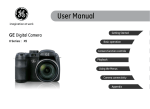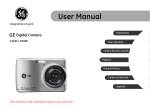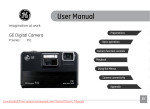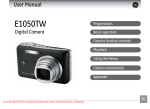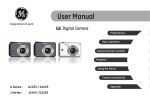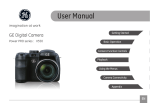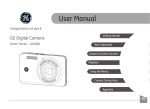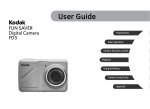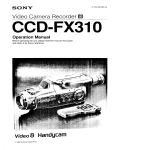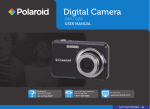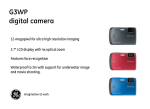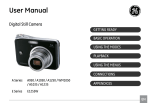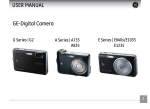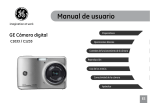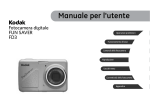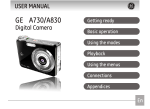Download User Manual - General Imaging
Transcript
User Manual
imagination at work
Preparations
GE Digital Camera
C1033 / C1233
Basic operation
Camera function controls
Playback
Using the Menus
Camera connectivity
Appendix
WARNING
Do not expose the camera battery pack or other accessories to
rain or humidity to prevent fire hazard or electric shock.
For customers in the U.S.A.
Tested To Comply With FCC Standards
FOR HOME OR OFFICE USE
This symbol [crossed-out wheeled bin WEEE Annex IV]
indicates separate collection of waste electrical and
electronic equipment in the European countries. Please
do not throw the equipment into the domestic refuse. Please
use the return and collection systems available in your country
for the disposal of this product.
Declaration of Conformity
FCC Statement
Model Name: C1033 / C1233
This device complies with part 15 of the FCC Rules. Operation
is subject to the following two conditions:
Trade Name:
GE
Responsible Party: General Imaging Co.
(1) This device may not cause harmful interference, and (2)
this device must accept any interference received, including
interference that may cause undesired operation.
Address:
For customers in Europe
(Outside U.S. & Canada: +1-310-755-6857)
"CE" mark indicates that this product complies
with the European requirements for safety, health,
environment and customer protection. "CE" marked cameras
are intended for sales in Europe.
Conforms to the following Standards:
1411 W. 190th Street, Suite 550, Gardena,
CA 90248, U.S.A.
Customer Service Telephone Number:
+1-800-730-6597
EMC:
EN 55022:1998/A1:2000/A2:2003 Class B
EN 55024:1998/A1:2001/A2:2003
EN 61000-3-2:2000/A1:2001
EN 61000-3-3:1995/A1:2001
following the provision of the EMC Directive (89/336/
EEC,2004/108/EEC)
SAFETY PRECAUTIONS
Camera notes:
Do not store or use the camera in the following types of
locations:
• In the rain, very humid and dusty places.
• In a place where the camera can be exposed directly to the
sunlight or subject to high temperature, e.g. Inside a closed
car in summer.
• In a place where the camera is subject to a high magnetic
field, e.g. near motors, transformers or magnets.
Do not place the camera on a wet surface or places where
dripping water or sand may come in contact with the camera,
which may cause irrepairable faults.
If the camera will not be used for a long period of time, we
suggest you remove the battery and the memory card from
the camera and keep them in dry environment.
If you carry the camera suddenly from a cold location to a
warm place, moisture may condense inside the camera. We
suggest you wait for a while before turing on the camera.
No compensation for loss of recordings. Loss of recordings
cannot be compensated for if a malfunction of your camera
or recording media, etc, makes the playback of recordings not
possible.
Battery notes:
Incorrect use of the batteries may cause them to leak, become
hot, ignite or burst. Always observe the precautions given below.
ii
• Do not expose the batteries to water, and take particular
care to keep the terminals dry.
• Do not heat the batteries or throw them into a fire.
• Do not attempt to deform, disassemble or modify the
batteries.
Keep the batteries out of reach of babies and small children.
In cold locations, battery performance deteriorates and the
time for which they can be used shortens markedly.
Memory card notes:
When using a new memory card, or a memory card has been
initialized by a PC, be sure to format the card with your digital
camera before using it.
To edit image data, copy the image data to the PC’s hard disk
first.
Do not change or delete the folder names or file names in the
memory card from your PC, as this may make it impossible
to recognize or misinterpret the original folder or file in your
camera.
The photos taken by this camera are stored in the autogenerated folder in SD card. Please do not store photos that
are not taken by this model of camera, as this may make it
impossible to recognize the picture when the camera is in
playback mode. Please do not expose the camera to harsh
environments such as moisture or extreme temperatures,
which may shorten the life of your camera or damage the
batteries.
BEFORE YOU START
Preface
Thank you for purchasing this GE digital camera. Please read
this manual carefully and keep it in a safe place for future
reference.
Copyright
© Copyright 2010 General Imaging Company All rights
reserved.
No part of this publication may be reproduced, transmitted,
transcribed, stored in a retrieval system, or translated into
any language or computer language, in any form, by any
means, without the prior written permission of General Imaging Company.
Safety information
Please read the following important information carefully
before using the product.
• Do not take apart or attempt to service the camera yourself.
• Do not drop or knock the camera. Improper handling may
damage the product.
• Turn off the camera before inserting or removing the battery and memory card.
• Use only the type of battery that come with the camera.
Using other types of batteries may damage the camera
and invalidate the warranty.
• Do not touch the camera lens.
Trademarks
All trademarks mentioned in this manual are used for identification purposes only and are properties of their respective
owners.
• Please not expose the camera to harsh environments such
as moisture, or extreme temperatures, which may shorten
the life of your camera or damage the batteries.
• Do not use or store the camera in dusty, dirty, or sandy
areas, as its components may be damaged.
• Do not expose the lens to direct sunlight for extended
periods.
• Download all pictures and remove the batteries from
the camera if you are going to store the camera for long
periods of time.
• Do not use abrasive cleansers, alcohol-based, or solventbased cleaners to clean the camera. To clean, wipe the
camera with a slightly damp soft cloth.
About this manual
This manual provides you with instructions on how to use your
GE digital camera. Every effort has been made to ensure that
the contents of this manual are accurate, however General
Imaging Company reserves the right to make changes without
notice.
Symbols used in this manual
Throughout this manual, the following symbols are used to
help you locate information quickly and easily:
Indicates the useful information to know.
Indicates precautions to be taken while operating the
camera.
CONTENTS
WARNING . ......................................................................i
SAFETY PRECAUTIONS .................................................ii
BEFORE YOU START ..................................................... 1
Preface . ........................................................................................1
Copyright .............................................................................1
Trademarks .........................................................................1
Using the Mode Button .......................................................... 13
Setting Date/Time and Language ....................................... 14
Setting the Date and Time ............................................ 14
Setting the Language .................................................... 15
About the LCD Screen . ........................................................... 16
BASIC OPERATION ..................................................... 17
Safety information .....................................................................1
Shooting in Auto Mode ........................................................... 17
About this manual . ....................................................................2
Using the Zoom Function . ..................................................... 17
Symbols used in this manual ..........................................2
Basic Functions Menu ............................................................ 18
Flash .................................................................................. 18
CONTENTS . ................................................................... 3
GETTING READY ........................................................... 7
Self-timer/Continuous Capture ................................... 19
Macro Mode ..................................................................... 19
Exposure Compensation................................................ 19
Unpacking ....................................................................................7
Advanced Functions Menu..................................................... 20
Camera Views .............................................................................8
WB (White Balance) ........................................................ 21
Inserting the Battery and SD/SDHC Card (Not included) 10
ISO ...................................................................................... 21
Turning On and Off .................................................................. 12
Quality . ............................................................................. 22
Size ..................................................................................... 22
Sunset . .............................................................................. 30
Color .................................................................................. 23
Glass .................................................................................. 30
Landscape ........................................................................ 30
USING THE MODES .................................................... 24
Night Portrait . ................................................................. 30
LCD Screen Display ................................................................. 24
Stabilization mode . .............................................................31
Still Picture Mode Display ............................................. 24
Face Detection ......................................................................... 32
Video Shooting Mode Display . ..................................... 26
Playback Mode Display . ................................................ 27
PLAYBACK ................................................................... 33
Panorama mode....................................................................... 28
Viewing Photos and Videos ................................................... 33
Scene mode .............................................................................. 29
Thumbnail View ....................................................................... 34
Sport .................................................................................. 29
Using Zoom on Playback (for still pictures only) . ............. 35
Indoor ................................................................................ 29
Using the Delete Button . ....................................................... 36
Snow .................................................................................. 30
Fireworks .......................................................................... 30
Museum ............................................................................ 30
Night Landscape ............................................................. 30
Children . ........................................................................... 30
Leaf .................................................................................... 30
USING THE MENUS .................................................... 37
Still Menu . ................................................................................. 37
AF Mode (Auto-Focus mode) . ....................................... 38
Continuous AF .................................................................. 38
Expo Metering (Exposure Metering) ............................ 39
Continuous Shot . ............................................................ 39
Setup Menu ............................................................................... 52
Date Imprint . ................................................................... 40
Beep ................................................................................... 53
Quick Review . .................................................................. 41
LCD Brightness ................................................................ 53
Digital Zoom . ................................................................... 41
Power Saver ..................................................................... 54
Movie Menu .............................................................................. 42
Zone ................................................................................... 54
Continuous AF .................................................................. 43
Date/Time . ....................................................................... 55
Expo Metering (Exposure Metering) ............................ 43
Language . ........................................................................ 55
Playback Menu . ....................................................................... 44
File and Software . ................................................................... 55
Protect . ............................................................................. 44
File Numbering ................................................................ 56
Delete ................................................................................ 45
Copy to Card (Copy internal memory to
memory card) .................................................................. 56
DPOF (Digital Print Order Format) .............................. 46
Trim .................................................................................... 47
Resize . ............................................................................... 47
Rotate . .............................................................................. 48
Red-eye Reduction.......................................................... 48
Reset Settings . ................................................................ 57
FW Version (Firmware version) . .................................. 57
Transmission . ............................................................ 58
Display Setup .......................................................................49
Video System ............................................................................ 58
Slideshow . ........................................................................ 49
Connecting to a PC . ................................................................ 59
Wallpaper Settings . ....................................................... 50
Setting the USB Mode .................................................... 59
Transferring Files to your PC ........................................ 59
Connecting to a PictBridge Compatible Printer ............... 61
Setting the USB Mode .................................................... 61
Connecting the Camera and Printer . ......................... 62
Using the PictBridge Menu . .................................................. 63
Print with Date ................................................................ 63
Print without Date .......................................................... 64
Print Index ........................................................................ 65
Print DPOF ........................................................................ 66
Exit ..................................................................................... 66
APPENDICES ............................................................... 67
Specifications: C1033 / C1233 . ............................................. 67
Error Messages ........................................................................ 71
Troubleshooting ...................................................................... 73
GETTING READY
Unpacking
Your package should contain the camera model you purchased along with the following items. If anything is missing or appears to
be damaged, please contact your vendor.
AA-size Alkaline Batteries
Warranty Card
USB Cable
Wrist Strap
CD-ROM
Camera Views
Front View
1
2
3
Back View
5
6
7
8
9
4
Right View
10
15
11
14
12
13
Top View
Bottom View
18
20
Left View
16
17
22
19
21
1
Flash Lamp
12
Flash Mode/Right Button
2
Timer Indicator
13
Delete Button/Down Button
3
Lens
14
Face Detection/Left button
4
Microphone
15
Function/OK Button
5
LCD Screen
16
USB/AV Port
6
Status Indicator
17
Wrist Strap
7
Zoom Button
18
Shutter Button
8
Playback Button
19
Power Button
9
Menu Button
20
Speaker
10
Mode Selection Button
21
Card Slot/Battery Compartment
11
Disp/Up Button
22
Tripod Socket
Insert the Battery and SD/SDHC Card (Not included)
1. Open the battery compartment.
10
2. Insert the enclosed batteries into the battery slot in the
correct direction.
3. Insert an SD/SDHC card (not included) into the memory
card slot as shown.
4. Close the battery compartment.
11
Optional SD/SDHC cards are not included. The use
of 64MB to16 GB memory cards from recognized
manufacturers such as SanDisk, Panasonic and Toshiba
is recommended for reliable data storage.
To remove the SD/SDHC card, open the battery
compartment and gently push the card to release it.
Pull the card out carefully.
Turning On and Off
Press the Power button to turn the camera on. To turn off the
camera, press the Power button again.
Power Button
When the camera is turned on, it will be at the same shooting
mode based on the last use. You can press the Mode button to
select a different one after it is on. When using the camera for
the first-time, the language setting page will appear. Please
see page 14 or the Quick Start Guide in the package for details.
12
Using the Mode Button
The GE camera provides a convenient Mode Button that allows you to switch between different modes with ease. Press Left/Right
button to choose the mode, press
to select. All the available modes are listed as follows:
Mode Name
Icon
Description
Auto mode
Switch to take still pictures in automatic mode.
Panorama mode
Switch to capture a sequence of shots and stitch them together into a panoramic photo.
Stabilization mode
Switch to take still pictures by reducing the blurs caused by hand shake, under low luminance, or
slow shutter speed.
Scene mode
Switch to take still pictures in 12 different scene types by your choice.
Movie mode
Switch to record videos.
Portrait
Switch to take portrait pictures under normal condition.
13
Setting Date/Time and Language
To set the language, date, and time, go to the following setup
options in the Setup menu.
• Date / Time
• Language
To access the Setup menu, do the following:
1. Press Power to turn the camera on.
2. Press the
button, switch among the setting menus by
using the Left/Right button to select the corresponding
basic setting menu.
3. Press the
button to confirm the setting.
Setting the Date and Time
1. Use the Up/Down button to select Date/Time. Then
press the Right button to enter the setting.
2. Press the Left/Right to highlight each field and use the
Up/Down to adjust the value.
3. Press the
button to confirm the setting.
14
Setting the Language
1. Use the Up/Down button to go to the Language. Then
press the Right button to enter the setting.
The Date/Time and Language setup will automatically
appear when the camera is turned on the first time.
2. Use the Left/Right buttons to select the desired language.
3. Press the
button to confirm the setting.
15
About the LCD Screen
When you turn the camera on, various icons are shown on the
LCD screen to indicate the current camera settings and status.
To learn more about the displayed icons, see “LCD Screen
display” on page 24.
LCD Screen notes:
Extremely high-precision technology had been used to
manufacture the LCD screen so that most of the pixels are
operational for use. However, there may be some minute
points (black, white, red, blue or green) that constantly
appear on the LCD screen. These points are normal in the
manufacturing process and the recording is not affected in
any way.
Avoid exposing the LCD screen to water; please remove
any moisture on the LCD screen with dry and soft
cleaning cloth.
16
If the LCD monitor is damaged, take particular care
with the liquid crystal in the monitor. If any of the
following situations arise, take the recommended
immediate action indicated below:
• If liquid crystal comes in contact with your skin, wipe the
area with a cloth and then wash thoroughly with soap and
running water.
• If liquid crystal gets into your eye, flush the affected eye
with clean water for at least 15 minutes and then seek
medical assistance.
• If liquid crystal is swallowed, flush your mouth thoroughly
with water. Drink large quantities of water and induce
vomiting. Then seek medical assistance immediately.
BASIC OPERATION
Shooting in Auto Mode
Using the Zoom Function
Auto mode is the easiest mode to take photos. While
operating in this mode, the camera automatically optimizes
your photos for best results.
To start shooting, do the following:
Your camera is equipped with two types of zoom functions:
optical zoom and digital zoom. Press the Zoom button of the
camera to zoom in or out on the subject while taking pictures.
Zoom button
1. Press Power to turn the camera on.
2. In the Mode menu, select the Auto mode (
).
3. Compose your picture on the LCD screen and press the
Shutter button halfway to focus on the subject.
4. The LCD screen will show green focus frame after the
subject is in focus.
5. Press Shutter fully to capture the image.
Zoom indicator (See
“Digital Zoom“ on
page 41)
When the optical zoom reaches its maximum value, release
the Zoom button then press it again for it to go further at the
digital zoom. Zoom indicator is hidden after the Zoom button
is released. The screen shows (
) for the current zoom
status.
17
Basic Functions Menu
The Basic Function Menus of the camera include Flash, Selftimer, Macro Capture, and Exposure Compensation. The
suitable function setting can let you shoot better photos.
Set the basic functions as per the following steps:
1. Pull up the Basic Function Menus by pressing Right/Flash
button.
4. Press Left/Right button to select the basic functions
required to set, press Up button to enter the setting
screen for selecting basic functions, or press
button to
confirm the settings and exit the screen.
Flash
2. Press Left/Right button to select the settings of the
required function.
button to confirm the settings and exit the menu,
3. Press
or press Down button to enter the selection screen of Basic
Function.
18
•
Flash : Auto
Camera flash goes off automatically based on
existing light conditions.
•
Flash : Red-eye reduction
The camera exposes a brief flash before the picture
is taken to reduce red-eye effects.
•
Flash : Forced flash
Flash always goes off.
•
•
•
Flash : Forced off
Flash is turned off.
•
Macro : On
Select this to focus on subjects 5cm from the lens.
Flash : Slow Synchro
This allows you to take pictures of people at night
that clearly show both your subjects and the night
time backdrop.
•
Flash : Red-Eye + Slow Synchro
Using this mode for slow synchro shots with red-eye
reduction.
Exposure Compensation
Self-timer/Continuous Capture
•
Self-time : 2 sec
A single picture is shot 2 seconds after the Shutter
button is pressed.
•
Self-time : 10 sec
A single picture is shot 10 seconds after the Shutter
button is pressed.
•
Self-time : Continuous Shot
Pictures are shot continuously when the Shutter
button is pressed down based on the Continuous
Shot settings in the menu. (See “Continuous Shot” on
page 39).
•
Macro Mode
Self-time : Off
Disable the self-timer.
Macro : Off
Select this option to disable Macro.
The exposure compensation allows you to adjust the light
exposure value and shoot the best photo.
The adjustable range of exposure value is from EV -2.0 to
EV+2.0.
19
Advanced Functions Menu
The Advanced Functions Menu of the camera include Image
Size, Image Quality, White Balance, Image Color and ISO etc.
The suitable function setting can let you shoot better photos
and videos.
Set the advanced functions as per the following steps:
1. Pull up the Advanced Function Menus by pressing
button.
4. Press Left/Right button to select the advanced functions
required to set, press Up button to enter the setting screen
for selecting advanced functions, or press
button to
confirm the settings and exit the screen.
2. Press Left/Right button to select the settings of the
required function.
20
3. Press
button to confirm the settings and exit the
menu, or press Down button to enter the selection screen
of Advanced Functions.
WB (White Balance)
ISO
The White Balance allows you to adjust the color temperature
under different light source to ensure faithful color
reproduction.
The ISO function allows you to set the sensitivity of the camera
sensor based on the brightness of the scene. To improve the
performance in darker environments, a higher ISO value is
required. On the other hand, a lower ISO value is needed when
in bright conditions.
Pictures at higher ISO will naturally have more noise than
those at lower ISO.
The options of White Balance include:
•
WB : Auto
•
WB : Daylight
•
WB : Cloudy
•
WB : Fluorescent
•
WB : Fluorescent CWF
•
WB : Incandescent
•
WB : Manual (Press the shutter button to set WB)
The options of ISO include automatic, 80, 100, 200, 400, 800
and 1600.
The available ISO values vary on different camera
models.
21
Quality
Size
The quality setting adjusts the compression ratio of the
images. Higher quality settings give better photos, but will
take up more memory space.
The size setting refers to the image resolution in pixels. A
higher image resolution allows you to print that image in
larger sizes without degrading the image quality.
The picture quality of image has totally three options:
22
•
Quality : Best
•
Quality : Fine
•
Quality : Normal
The bigger the number of recorded pixels is, the better
the image quality becomes. As the number of recorded
pixels becomes smaller, you will be able to record more
frames on a memory card.
Color
The color setting allows you to add artistic effects directly
when taking pictures. You can try different color tones to alter
the mood of your pictures.
The color options include:
•
Color : Auto
•
Color : Black & White
•
Color : Sepia
•
Color : Vivid
23
USING THE MODES
LCD Screen Display
Still Picture Mode Display
1 Shooting Mode Icons
Mode:
1
2
3
4
5
6
7
Auto mode
Scene mode
Stabilization mode
Portrait
8
Panorama mode
9
16
10
15
14
11
2 AF Mode
Single-AF
Multi-AF
3 Expo Metering
13
17
18
19
20
21
12
Spot
Center
AiAE
4 Image Size
5 Image Quality
24
6 Remaining number of pictures
7 Memory card/built-in memory
21 Flash Mode
Flash : Auto
8 Battery Status
9 WT Ratio (Displayed only when zoom is activated)
10 Zoom
11 Exposure
12 ISO Value
13 Histogram
14 Focus Frame
15 Continuous Shot
16 Face Detection
Flash : Red-eye reduction
Flash : Forced flash
Flash : Forced off
Flash : Slow Synchro
Flash : Red-Eye + Slow Synchro
17 Picture Color
18 White Balance
19 Macro Mode
20 Self-timer
Self-time : 2-sec
Self-time : 10-sec
25
Video Shooting Mode Display
4 Video Quality
5 Focus Frame
Mode :
6 Self-timer
1
2
3
4
5
6
7
8
9
Self-time : 2-sec
10
13
11
Self-time : 10-sec
7 Remaining Time for Video Recording
8 Memory Card/Built-in Memory
9 Battery Status
12
10 WT Ratio (Displayed only when zoom is activated)
11 Zoom
12 Exposure
1 Video Mode icon
2 Continuous AF
Single-AF
3 Metering
26
Spot
Center
AiAE
13 Recording Status Icon
Recording standby
Recording
For optimal video shooting, it is recommended that the
SD card be used. If you shoot videos with the limited
built-in memory as a result of short video recording,
there may be picture jitter and noise.
During video shooting, the optical zoom is fixed but the
highest 5.7x digital zoom is still available.
Playback mode display
1. Play Mode icon
2. Picture File
Mode:
3. File protection
4. Picture Number
1
2
3
4
5
5. Memory Card/Built-in Memory
6
6. Battery Status
7. Image Zoom
7
12
8. The current display area
9. Affecting regional
10.Memory Space (this picture/Total number of pictures)
8
9
11
11.Recording Date and Time
12.DPOF file
10
27
Panorama mode
Panorama Mode allows you to create a panoramic picture. The
camera will automatically compose a panoramic picture using
the individual shots that you take.
Follow these steps to create a panoramic picture:
1. Turn the mode dial to the Panorama Mode. Then enter
the Photo Setup to Select either Auto Stitching or Manual
Stitching (Please refer to Page 37 to enter the Still Picture
Menu.)
2. Use the Left/Right buttons to specify the direction of
picture taking, and then in 2 seconds the panoramic
sequence will commence automatically.
3. Compose the first view of the panoramic picture on the
LCD screen and press the Shutter button to capture.
4. After the first shot is taken, the semi-transparent image of
the first shot will appear at the edge of the screen. You can
use this image to compose your picture before you press
the Shutter button to capture and finish manual stitching.
5. The camera will then stitch the pictures into a panorama
automatically.
button to enter Playback mode and review
6. Press the
the panorama result.
After taking a Panoramic picture press the func/ok button to save and exit or press the Delete button to cancel
and exit.
Flash Mode, Self-timer, Macro Mode, and Exposure Compensation are disabled on Panorama Mode.
Pictures cannot be deleted, nor the zoom adjusted until
the series is finalized.
Panorama Mode can stitch 2 or 3 maximum pictures.
28
Scene mode
In Manual Scene mode, you can select from a total of 12
scene types to match your needs. You just need to select the
right scene for the occasion and the camera will automatically
adjust to the optimal settings for you.
Select a scene using the Left/Right button and press the
button.
Icon
Press the
button, select the Scene Mode menu with the
Left/Right button, and the LCD screen will show the figure as
below.
Mode Name
Icon
Mode Name
Sport
Indoor
Snow
Fireworks
Museum
Night Landscape
Children
Leaf
Sunset
Glass
Landscape
Night Portrait
Sport
For shooting fast-moving objects. Bring lively pictures to life.
Indoor
For shooting people indoors. Clearly show background and
atmosphere.
29
Snow
Leaf
Suitable for snowy landscape. Camera automatically adjusts
and corrects exposure value (EV).
For shooting plants. Vivid reproduction of green.
Fireworks
For shooting sunsets. Vivid reproduction of red and yellow.
For shooting at night and fireworks. Shutterspeed is slower
than normal. (Use of tripod is recommended)
Glass
Museum
For shooting in museums or places where flash is not allowed.
Night landscape
For shooting night scenes. Use of tripod is recommended.
Children
Suitable for photographing children and pets. The flash shuts
off automatically in order not to disturb the subject being
photographed.
30
Sunset
Suitable for photographing objects behind glass or window.
Landscape
For shooting landscapes. Vivid reproduction of green and blue.
Night portrait
For shooting portraits with night scenes as background.
Stabilization mode
This mode can help reduce photo blur caused by hand shake,
low light and slow shutter speed
1. After selecting the scene type, press the
activate.
button to
2. To select a different scene type, press the
button
to enter the main function menu. Then press it again to
return to the to Scene selection menu.
The main function menu also allows you to adjust the image
quality and image size. Please refer to the "Advanced
Functions Menu" section on page 20 for detailed
instructions.
Use stabilization mode in dark environments or when in
slow shutter speed
Shooting in a windy or unstable environment (such as a
moving vehicle) may cause blurred images.
31
Face Detection
The Face Detection mode will detect and focus on faces of
persons during picture shooting so that the faces will be
clearer.
1. In Shooting Mode, press the Left/Face Detection button to
turn on the Face Detection and an icon (
) appears on
the LCD.
2. Hold the camera securely, and point the camera towards
the subject to start the face detection process. When the
camera detects a face, a white rectangular frame will be
drawn around the face. (Note: For best results, the face of
the subject should be relatively large on the LCD screen,
and the subject should be facing the camera as front on as
possible.)
3. Press Shutter halfway to focus on the subject.
4. Press Shutter fully to capture the image.
5. Press the Left/Face Detection button to turn off Face
Detection.
32
PLAYBACK
Viewing Photos and Videos
To view the captured photos and video clips on the LCD screen:
1. Press button to go to the Playback mode. The last
recorded photo or video clip is displayed.
2. Use the Left/Right navigation buttons to scroll through
the photos or video clips stored in the internal memory or
memory card.
3. To play a selected video clip, press the
the movie playback mode.
6
button to enter
During video playback, the operating instructions will appear
on the screen. Press the Left/Right button, and press the
button for confirmation.
1
The operating instruction icons are as follows.
1
First Frame
4
Back
2
Play
5
Rewind
3
Fast Forward
6
Pause
2
3
4
5
33
During video playback, you can press the Up/Down button to
adjust the volume.
Thumbnail View
When in Playback mode, press one end of the Zoom button
(
) to display the thumbnail of photos and videos on the
screen.
1. Use the Zoom button to switch between the 2x2, 3x3, and
4x4 thumbnail display.
2. Use Up/Down/Left/Right to select a photo or video clip
to view.
If the
indicator appears on the LCD, then a movie
file is currently being displayed.
Press the
button to restore a preview icon to its
original image size.
34
Using Zoom Playback (for still pictures only)
The zoom buttons can also be used during playback. This
allows you to magnify photos up to 2 ~ 8X.
1. Press
button to go to the Playback mode.
2. Use the Left/Right navigation buttons to select a photo
to magnify.
3. Press one end of the Zoom button (
) to zoom in.
5. Use the navigation buttons to pan across the image.
6. Press the
scale.
button to return the image to its original
Movie images cannot be magnified.
4. Use the Zoom buttons to zoom in and out. The zoom
indication and the frame of the whole photo shall display
on the screen.
35
Using the Delete Button
In Playback Mode, you can press the Down/Delete button to
delete pictures or videos.
To delete pictures or videos:
1. Press
button to go to the Playback Mode.
2. Select a picture or video clip you want to delete with the
Left/Right button.
3. Press the Down/Delete button and the delete screen
appears.
36
4. Select Yes or Back with Up/Down button and press the
button for confirmation.
Erased photos/video clips cannot be recovered.
Please refer to page 45 for instructions on the Delete
Menu options.
USING THE MENUS
Still Menu
Mode:
In any of the above Still Picture Modes, press the
go to the Still Picture menu.
button to
To adjust each setting:
1. In the Still Picture menu, switch between different Photo
Setup or Camera Setup pages using the Left/Right button,
to select the page with the function you want to adjust
and press the Down button.
4. Press Up/Down button to select an option or press the Left
or
button to return to the menu.
5. Press the
button for confirmation and exit the menu.
After selecting a function, you can press the Up button
to return to the Still Picture menu for other Photo Setup
or Camera Setup pages. Or you can press the Down
button several times to move to the next setup menu
page.
2. Press the Up/Down buttons to select the function.
Refer to the following pages for more details about each
setting.
3. Press the Right button to go to the submenu.
37
AF Mode (Auto-Focus mode)
Continuous AF
Use this setting to control the auto-focus mechanism while
taking pictures.
After Continuous AF is turned on, the camera will adjust
focus automatically in response to any camera or subject
movement.
Two options are available:
• Single-AF: The focus frame appears on the center of the
LCD screen to focus on the subject.
• Multi-AF: The camera automatically focuses the subject
in a wide area to find the focus point.
38
Expo Metering (Exposure Metering)
Continuous Shot
Use this setting to select an area for the exposure to be
obtained.
Use this setting to perform continuous shooting. Once in this
mode, you must continuously hold down the Shutter button to
use this function.
Three options are available:
• Spot
• Center-Weight
• AiAE (Artificial Intelligence AE)
Four options are available:
• Unlimited: Press and hold the shutter to shoot continuously until you release the shutter or when the memory
card has run out of space.
• 3 shot: Capture up to 3 consecutive pictures.
• 3 shots (Last): Capture pictures continuously until the
Shutter button is released but only the last 3 shots are
recorded.
• Time-Lapse: Automatically capture pictures in a predefined interval.
39
The flash is designed not to work in this mode in order
to enable quick succession of shots.
Date Imprint
Include a Date/Time stamp in the photo image.
Continuous Shot can only be selected in Self-timer
Mode.
• Off
• Date
• Date / Time
40
Quick Review
Digital Zoom
This setting refers to the quick photo review immediately after
taking a picture. The picture stays on the LCD screen for an
adjustable period of time.
Use this setting to enable or disable the digital zoom function.
When disabled, only the optical zoom is enabled.
Four options are available:
• Off
• 1 sec
• 2 sec
• 3 sec
41
Movie Menu
Mode:
In the Movie Mode, press the
sponding Movie menu.
button to go to the corre-
To configure each setting:
1. In the Movie menu, switch between the Movie Setup or
different Camera Setup pages using the Left/Right button,
select the page with the function you want to adjust and
press the Down button.
3. Press the Up/Down button to select an option or the Left
or
button to return to the menu.
4. Press the
button for confirmation and exit the menu.
Refer to the following pages for more details about each
setting.
2. Press the Up/Down button to select the function and press
the Right button to go to the submenu.
42
Continuous AF
Expo Metering (Exposure Metering)
After Continuous AF is turned on, the camera will adjust
focus automatically in response to any camera or subject
movement.
Set metering mode for various lighting conditions.
Three options are available:
• Spot
• Center
• AiAE (Artificial Intelligence AE)
43
Playback Menu
Protect
Mode :
In Playback mode, press the
menu.
button to enter the Playback
Please refer to the following sections for detailed instructions
on the various menu options.
To prevent any pictures or videos from being accidentally
erased, use this setting to lock one or all of the files.
To protect/unprotect a picture or video:
1. Press button and find the picture or video you want to
protect by using Left/Right button. Once it is displayed
on the screen, go to the Playback menu, select Protect
settings and press the Up/Down button to make your
selection.
2. Press the Up/Down button to select the protection setting
option and press the Right button to go to the submenu.
44
3. Use the Up/Down navigation buttons to select One
to protect this picture/video, or select All to protect all
pictures/videos in the internal memory or memory card.
Then press the Right navigation button to enter the
submenu.
Delete
There are two ways to delete files.
button to select Yes to lock. For locked
4. Press the
picture/video, use Unlock option to unlock it.
5. A key (
) icon will appear on the top of the screen to
indicate that the picture/video is protected.
6. Select Reset on the Protection setting to cancel protection
for all files that have been placed in the protected mode.
• Delete One:
1. In the Delete Option, select One and then press
button.
2. Using the Left/Right buttons, locate the photo or movie
file to be deleted. Select Yes (to delete file) or No (to return
to the previous menu) using the Up/Down buttons, then
press the
button to confirm.
45
DPOF (Digital Print Order Format)
• Delete All:
1. In the Delete option, select All and then press
button.
2. Using the Up/Down buttons, select Yes (to delete all files)
or No (to cancel and return to the previous menu).
The “
” indicator means a file is protected. File
protection must be removed first before a file can be
deleted.
Deleting files will cause DPOF settings to be reset.
46
DPOF allows you to record your selection of pictures that
you would like to print, and will save your selection in the
memory card, so that you can simply hand your memory card
to a photo kiosk without having to tell them in person which
photos you would like to print.
Trim
Resize
The Trim setting allows you select an area of the photo you
want to keep and then save it as a new photo.
This setting allows you to resize a picture to a specified
resolution, and saves it as a new picture.
To trim a picture:
1. Select the Resize setting from the Playback menu as
described previously.
1. Select the Trim setting from the
menu.
2. Using the Left/Right buttons, locate the photo that you
want to crop and have it displayed on the LCD.
3. Use the zoom buttons and navigation buttons to adjust
the trimming box to fit the location and size of the new
picture.
2. Use the Left/Right navigation buttons to select a picture
to resize.
4. Press the Shutter button to save what you see on the LCD
screen as a new picture, or the
button to cancel and
return to the Playback menu.
The image can not be clipped again when it is clipped to
640X480.
3. Use the Up/Down navigation buttons to select a
resolution (1024X768 or 640X480) to resize the image or
Back to cancel and return to the Playback menu.
4. Press the
button to confirm the setting.
Resizing an image creates a new file that contains the
image in the size you select. The file with the original
image also remains in memory.
47
If the message “The image cannot be edited.” appears,
it means that the current image cannot be resized.
Rotate
You can use this setting to change the picture orientation of
the picture.
1. Select the Rotate setting from the Playback menu as
described previously.
2. Use the Left/Right navigation buttons to select a picture
to rotate.
Red-eye Reduction
Use this setting to remove red-eyes in your photos.
1. Select the Red-eye Reduction in Playback menu as
described previously.
2. Use the Left/Right button to select the picture from
which the red-eye needs to be removed.
3. Use the Up/Down navigation buttons to select Yes to fix
the selected image or Back to cancel and return to the
Playback menu.
3. Use the Up/Down navigation buttons to select the
direction for rotation or Back to cancel and return to the
Playback menu.
4. Press the
4. Press the
48
button to confirm the setting.
button to confirm the setting.
For best results, the face of the subject should be
relatively large on the LCD screen, the subject should be
facing the camera as front on as possible, and the red
eyes should be as large as possible.
Display Setup
Slideshow
Mode:
Press
menu.
button in Playback mode to enter Display Setup
This setting allows you to view all the stored pictures as a
slideshow.
1. Select the slideshow menu, press the right button to enter
the options menu.
2. Use the Up/Down navigation buttons to select Effect,
Interval time, or Repeat and use the Left / Right
navigation buttons to adjust the setting.
Refer to the following sections for details of every setting.
3. Use the Up/Down navigation buttons to select Start to
run the slideshow or Cancel to return to the Playback
menu.
4. Press the
button to confirm the setting.
49
Wallpaper Settings
Menu Wallpaper:
Use this setting to select your favorite picture to use as a
background on the LCD screen.
Use Up/Down button to select the Menu Wallpaper option,
press
button to confirm or press Left button to return to
1. Press Down button to select the Wallpaper Setting menu.
last page, and press
2. Press Right button, and the camera will enter the
Wallpaper Setting interface.
• User
• Nature
• Sparkling
50
to exit the menu.
Startup Screen:
Set back to defaults:
Use Up/Down button to select the Startup Screen option, press
to confirm or press Left button to return to last page, and
Use Up/Down button to select Set back to defaults, press
to confirm or press Left button to return to last page, and
press
to exit the menu.
press
to exit the menu.
• User
• Yes
• GE logo
• No
51
Setup Menu
Mode :
The Setup menu for the camera is available in all modes. Each
menu page can be selected by pressing the
button and
switching between menus with the Left/Right button.
2. Switch between different functions with the Up/Down
button.
3. Press the Right button to enter the submenu.
After selecting a function option, you can press the Up
button to return to the menu for other Camera Setup
pages. Or you can press the Down button to switch to
the next menu page.
Refer to the following pages for more details about each
setting.
To adjust the settings:
1. Select the menu page with the function you want to adjust
and press the Down button.
52
Beep
LCD Brightness
Use this setting to adjust the volume of beep when buttons are
pressed and change the tones for Shutter button, self-timer,
and power-on/power-off.
Use this setting to adjust the brightness of your LCD screen.
To change this setting:
2. Select auto or adjust the brightness level using the
Left/Right button, and press the
button to confirm the
setting.
1. Select the Beep setting from the Setup menu as described
previously.
1. Select the LCD Brightness setting from the Setup menu
as described previously.
2. Use the Up/Down navigation buttons to switch between
volume, shutter tone, key tone, self-timer tone, and power
tone fields.
3. Press the Right button, press the Up/Down button to
adjust volume and change tone, and press the
button
to confirm setting.
53
Power Saver
This setting allows you to save power and get the maximum
possible running time for your battery. Follow the steps below
to turn off the LCD screen and camera automatically after a
period of inactivity.
1. Select the Power Save setting from the Setup menu as
described previously.
2. Press the Up/Down button to select the power items for
the screen and camera and press the Right button.
• Turn off the LCD:
30 sec, 1 min, 2 min, and off.
• Turn off the camera:
3 min, 5 min, 10 min, and off.
4. Press the
button to confirm.
Zone
The Zone setting is a useful function on your overseas trips.
This feature enables you to display the local time on the LCD
screen while you are overseas.
1. Select the Zone setting from the Setup menu as
described previously. The world time screen appears.
2. Use the Up/Down navigation buttons to switch between
the hometown (
) and travel destination (
) fields.
3. Use the Left/Right navigation buttons to select a city
close to the desired time zone. Then press the
button
to confirm.
3. Press the Up/Down button to adjust the selected item.
Both items have the following options:
54
File and Software
Format Memory
Please note: formatting enables you to delete all contents in
the memory card and built-in memory, including protected
photo and movie files.
To use this setting:
1. Select the Format in File and Software menu.
Date/Time
2. Use the Up/Down navigation buttons to select Yes or No.
Then press the
button to confirm.
See “Setting the Date and Time“ section on page 14.
Language
See “Setting the Language“ section on page 15.
3. The current media is formatted.
55
File Numbering
After you take a picture or video clip, the camera will save it
as file that ends with a serial number. You can use this item to
choose whether the file is serially numbered or begins with 1
and is saved in another folder on the memory card.
56
Copy to Card (Copy internal memory to memory
card)
Use this setting to copy the files stored in the internal memory
to the memory card.
1. Select the File Name in File and Software menu.
1. Select the Copy to memory card in File and Software
menu.
2. Select the option with the Up/Down button and press the
button for confirmation.
2. Use the Up/Down navigation buttons to select Yes or No.
Then press the
button to confirm.
Reset Settings
FW Version (Firmware Version)
Use this setting to restore the camera to its default settings.
Use this setting to view the current camera firmware version.
1. Select the Reset setting in File and Software menu.
1. Select the FW Version in File and Software menu.
2. Use the Up/Down navigation buttons to select Yes or No.
Then press the
button to confirm.
2. If SD card contains a new version of firmware, please
upgrade accordingly as necessary.
To update to the latest firmware version, you can go to
the following website:www.ge.com/digitalcameras and
look under Support.
57
Transmission
Video System
Use this setting to determine your video system in the current
area.
1. Select the Video System in Connection Setup menu.
2. Use the Up/Down navigation buttons to select NTSC or
PAL. Then press the
button to confirm.
58
The video output signal can be switched to NTSC or PAL to
accommodate different regional standards. The appropriate
setting will vary between regions.
NTSC: USA, Canada, Taiwan, Japan, etc.
PAL:
Europe, Asia (excluding Taiwan), Oceania, etc.
Note: The TV output will not display properly if an incorrect
video system is selected.
Connecting to a PC
Use the USB cable and ArcSoft software (CD-ROM) supplied
with your camera to copy (transfer) pictures to a computer.
Setting the USB mode
Since the camera’s USB port can be set to connect with either
a PC or a Printer, the following steps will allow you to ensure
that the camera is correctly configured to connect with a PC.
1. Go to the camera setting menu, select USB connection
with the Up/Down button, and press the Right button.
2. Use the Up/Down navigation buttons to select PC.
3. Press the
button to confirm the setting.
Transferring files to your PC
The computer will automatically detect the camera as a
removable drive. Double-click My Computer icon on the
desktop to locate the removable drive and to copy the folders
and files in the drive to a directory on your PC as you would
copy any typical folder or file.
By using the USB cable, you can transfer the captured photos
and videos to a PC. Follow the steps below to connect the
camera to a PC.
1. Start a computer to which ArcSoft software has been
installed.
2. Make sure both the camera and PC are turned on.
3. Connect one end of the supplied USB cable to the USB/AV
OUT port on your camera.
4. Connect the other end of the cable to an available USB
port on your PC.
59
Windows operating system (Windows 2000, Windows XP,
Windows Vista, Windows 7.)
Click the [Safely remove the hardware] icon and remove
the USB connector according to the appeared menu.
5. Disconnect the camera once transfer is completed.
If the USB option is set to [PC] :
Turn the camera off and disconnect the USB cable.
If the USB option is set to [PC (PTP) ] :
Remove the camera from the system as described below
before turning the camera off and disconnecting the USB
cable.
60
Macintosh
Drag the untitled icon to the Trash. ("Untitled")
Connecting to a PictBridge Compatible Printer
PictBridge allows printing images from a
memory card in a digital camera directly to
a printer, regardless of brand. To find out if a
printer is PictBridge compatible, simply look for
the PictBridge logo on the packaging or check
the manual for specifications.With the PictBridge function on
your camera, you can print the captured photos directly with
a PictBridge compatible printer using the supplied USB cable,
without the need for a PC.
3. Press the
button to confirm the setting.
Setting the USB mode
Since the camera’s USB port can be set to connect with either
a PC or a Printer, the following steps will allow you to ensure
that the camera is correctly configured to connect with a
Printer.
1. Go to the camera setting menu, select USB connection
with the Up/Down button, and press the Right button.
After the camera is reset, it will switch to PC mode
automatically from USB mode.
2. Use Up/Down to select Printer.
61
Connecting the camera and printer.
1. Make sure both the camera and printer are turned on.
If the camera is not connected to a PictBridge compatible
printer, the following error message appears on the LCD
screen.
2. Connect one end of the supplied USB cable to the USB port
on your camera.
3. Connect the other end of the cable to the USB port on the
printer.
The above error message would also appear if the USB
mode were set incorrectly, in which case you should
disconnect the USB cable, check the USB mode settings,
ensure that the Printer is turned on, and then try
connecting the USB cable again.
62
Using the PictBridge Menu
After setting the USB mode to Printer, the PictBridge menu
appears.
Print with date
If you have set the date and time of your camera, the date and
time will be recorded and saved with each photo you take.
1. Select Print with date from the PictBridge menu. The
following screen appears.
Select a menu item with the Up/Down button and press the
Right button or
button to enter the item.
Refer to the following sections for more detailed information
on each setting.
2. Use the Left/Right navigation buttons to scroll through
the photos.
63
3. Use the Up/Down navigation buttons to select the
number of prints for the current displayed photo.
4. Press the
button and the following screen appears.
5. Select Yes to confirm the printing, or Cancel. Then press
the
button.
Print without date
Use this setting to print the photos without dates on them.
1. Select Print without date from the PictBridge menu.
The following screen appears.
2. Use the Left/Right navigation buttons to scroll through
the images.
3. Use the Up/Down navigation buttons to select the
number of prints for the current displayed image.
4. Press the
64
button and the following screen appears.
5. Select Yes to confirm the printing, or Cancel. Then press
the
button.
2. Select Yes to confirm the printing, or Cancel. Then press
the
button.
Print index
You can use this setting to print all indexes to show all the
photos currently in your camera.
1. Select Print index from the PictBridge menu. The
following screen appears.
65
Print DPOF (Digital Print Order Format)
Exit
To use DPOF printing, you must make the selection of photos
for printing using the DPOF settings before hand. See “DPOF”
section on page 46.
To exit the PictBridge menu, select Exit. The “Remove USB
cable” message will be displayed.
1. Select Print DPOF from the PictBridge menu. The following screen appears.
Disconnect the USB cable from the camera and printer.
2. Select Yes to confirm the printing, or Cancel. Then press
the
button.
66
APPENDICES
Specifications : C1033 / C1233
Design and specifications are subject to change without notice.
Model name
C1033
C1233
Effective Image Sensor Pixels
10.1 Megapixels
12.1 Megapixels
Image Sensor
10.3 Megapixels [1/2.5” (CCD)]
12.2 Megapixels [1/2.3” (CCD)]
Lens
Focal Length F =
5.2mm (Wide) ~ 15.6mm (Tele)
35mm film equivalent
31.2mm (Wide) ~ 93.6mm (Tele)
F number
F3.5 (Wide) ~ F6.4 (Tele)
Construction
7 elements in 7 groups
Optical Zoom
3X
Focusing Range
Normal: (Wide) 30cm ~∞, (Tele) 80cm ~ ∞;
Macro: (Wide) 5cm ~ 60cm
Anti-Handshake
Electronic Image Stabilization
Digital Zoom
5.7X digital zoom (Combined Zoom: 17.1X)
28.8mm (Wide) ~ 86.4mm (Tele)
67
Model name
Number of
Recording
Pixels
C1233
Still Image
10MP, 9MP(3:2), 8MP, 7MP(16:9), 5MP,
3MP, 0.3MP
Movie
640x480pixels: 30fps/15fps, 320x240pixels: 30fps/15fps
Image Compression
Best, Fine, Normal
DCF, DPOF (Ver1.1) Support
Yes
File Format
68
C1033
12MP, 10MP(3:2), 9MP(16:9), 10MP, 8MP,
5MP, 3MP, 0.3MP
Still Image
Exif 2.2 (JPEG)
Movie
Quick Time Motion JPEG, Audio: G.711 [Monaural])
Shooting Modes
Auto, Scene (Sport, Indoor, Snow, Fireworks, Museum, Night Landscape, Children,
Leaf, Sunset, Glass, Landscape, Night Portrait), Stabilization, Portrait, Panorama,
Video
Face-Detection
Yes
Red-eye Removal
Yes
Model name
C1033
C1233
Pan-Capture Panorama
Yes
LCD Display
2.4 inch (112,320 pixels) LTPS (low-temperature polycrystalline silicon) TFT color
LCD
ISO Sensitivity
Auto, ISO80/100/200/400/800/1600
AF Method
Single AF, Multi-AF (TTL 9-point), Face-Detection
Light Metering Method
Artificial Intelligence AE (AiAE), Center-weighted Average, Spot (Fixed to center of
frame)
Exposure Control Method
ProgramAE (AE-lock available)
Exposure Compensation
±2 EV in 1/3 Step increments
Shutter Speed
4 ~ 1/2000 second
Continuous Shooting
Approx. 2.05 fps (Large/Fine mode)
Playback Modes
Single Photo, Index (4/9/16 thumbnails), Slide Show, Movie (Slow-Motion
possible), Zoom (Approx. 2X~8X), Audio, Histogram Display
White Balance Control
Auto (AWB), Daylight, Cloudy, Fluorescent , Fluorescent CWF, Incandescent,
Manual
Approx. 1.28 fps (Large/Fine mode)
69
Model name
Internal Flash (Shooting Range)
C1033
C1233
Auto/Red-Eye Reduction/Forced Flash/No Flash/Slow Synchro/Red-Eye
Reduction+Slow Synchro
Shooting Range Wide: Approx. 0.3m~2.3m / Tele: Approx. 0.3m ~ 1.9m (ISO 400)
Internal Memory: 5MB
Internal Memory: 7.57MB
Recording Media
SD Card/SDHC Card (Up to 16GB
support)
SD Card/SDHC Card (Up to 32GB
support)
Other Features
PictBridge, ExifPrint Support, Multi-language Sup port
Jacks
USB2.0/AV-OUT (Integrated Proprietary Connector)
Power
2 x AA Alkaline Battery, AA NiMH Battery [Not Included]
Shooting Capability (Battery Performance)
70
AA Alkaline Batteries: Approx. 130 shots (based on CIPA standards)
AA NiMH Battery : Approx. 380 shots (CIPA Standards)
o
Operation Environment
Temperature: 0~40 C, Humidity: 0~90%
Dimensions (W x H x D)
91.5mm x 60.2mm x 30.2 mm
Mass
Approx. 118g (Body only)
Approx. 120g (Body only)
Error messages
Messages
Explanation
No card
• The memory card is not inserted.
Card error
• The memory card is not formatted.
Card full
• The memory card is full and cannot store any new images.
Write protect
• The memory card is write-protected.
Picture error
• The picture is not captured correctly.
• The picture is damaged.
No picture
• There are no images in the memory card or in the internal memory.
Lens error
• The lens is probably stuck and the camera will power off automatically.
System error
• Unexpected error encountered.
Image cannot be saved
• The write protection switch in the memory card is set to the “LOCK” position.
Out of the range
• When pictures were taken in Panorama mode, the direction of movement was
incorrect or the angle was outside the range of the internal settings.
The maximum specified water depth was
exceeded
• During underwater recording or shooting, the camera was taken deeper than the
maximum allowable depth.
71
Messages
Explanation
When the camera is used for longer than
the specified time it may be damaged.
• During underwater recording or shooting, the camera was kept under water
longer than the specified time.
Card is not formatted, format?
• Confirm whether the memory card should be formatted.
This image cannot be deleted
• The picture or video you are trying to delete is protected.
Cannot record movie
• The write protection switch in the memory card is set to the “LOCK” position.
Warning!! Camera recording, please wait.
• No other actions allowed to perform during video/audio recording.
Warning!! Battery exhausted.
• The battery is out of charge.
This file cannot be played back
• The picture format cannot be recognized by the camera.
No connection
• The camera is not connected to the printer correctly.
Print error
• There is a problem with camera or printer.
Cannot print
• Check that the printer is out of paper or out of ink.
• Check if the printer has a paper jam.
72
Troubleshooting
Problem
Camera does not turn on.
Possible causes
• The battery has run out.
Solution
• Replace with a fully charged battery.
• The battery is not inserted correctly.
Camera turns off suddenly during
operation.
• The battery has run out.
• Replace with a fully charged battery.
The picture is blurred.
• The lens is dirty.
• Use a soft cloth to clean the lens on your
camera
•
appears when taking pictures.
Images and video files cannot be
saved.
• The memory card is full.
• Use the Image Stabilization mode.
• Replace the memory card with a new one.
• Delete unwanted images.
• Unlock the memory card.
73
Problem
No picture is taken when pressing
the Shutter button.
Images cannot print from the connected printer.
Possible causes
• The memory card is full.
• No available space to store the
files.
• Replace the memory card with a new one or
clean off current memory card.
• Delete unwanted images.
• The mode dial is in Playback mode.
• The memory card is locked.
• The camera is not connected to the
printer correctly.
• Check the connection between the camera
and printer.
• The printer is not PictBridge compatible.
• Use a PictBridge compatible printer.
• The printer is out of paper or out of
ink.
• Replace the ink cartridge in the printer.
• The paper is jammed.
74
Solution
• Load some paper in the printer.
• Remove the jammed paper.
http://www.ge.com/digitalcameras
© 2010 General Imaging Company
Printed in China














































































